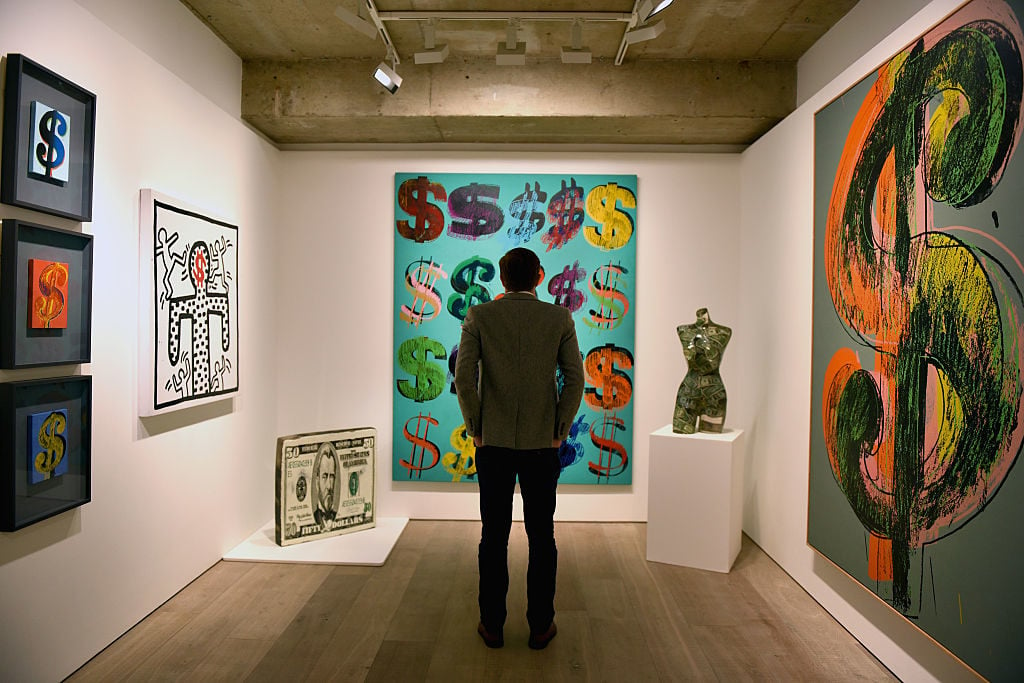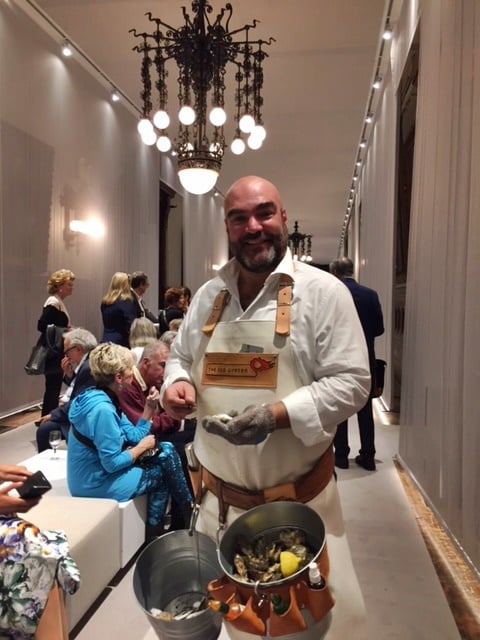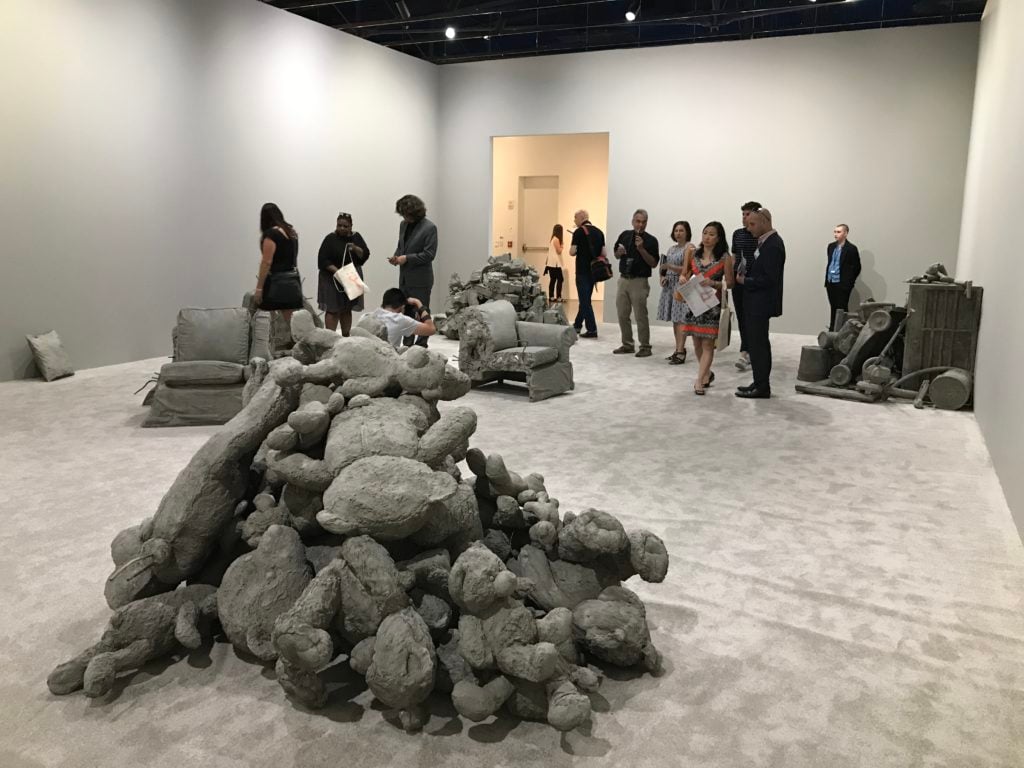

Opinion
The Toxic Legacy of Zombie Formalism, Part 2: How the Art System’s Entropy Is Raising the Political Stakes for Culture
Debt Aesthetics make new political themes increasingly attractive.
Read the first part of this series, here.
What I am calling Debt Aesthetics—how financial speculation and economic bifurcation have flattened art into a new form—are not limited to Zombie Formalism. That would make them hopelessly antiquated. By now, the churn of boom-and-bust trend cycles has spurred the market onto greener pastures, leaving Zombie Formalism in the dust.
Predictably, this has meant a pendulum swing back toward figuration, as collectors flee the taint of abstraction like a herd of frightened sheep. Also popular of late have been works that have the flavor of so-called Outsider Art (produced by the untrained or the marginalized), with the fetishistic air of “authenticity” affiliated with the genre since it was popularized by Jean Dubuffet in the late 1940s.
Even so, Zombie Formalism has been the most visible contemporary product of Debt Aesthetics, and the process it describes. Works in this vein provide a kind of decryption key to define the qualities to spot Debt Aesthetics more broadly: they have some of the properties of currency, made in series and nearly interchangeable; their content is almost exclusively borrowed—specifically, via reassuring historical resonance with Abstract Expressionist and Color Field painting—providing a sense of security for the buyer; and they can be read and appreciated quickly, the better to reduce friction of transaction.
They are fungible, friendly, and fast. Above all else, they appear to have been made solely for the market.
***
Let’s again take the example of Lucien Smith. Beginning in 2011, Smith began making the series of works that would make him famous, which he collectively dubbed “Rain Paintings.” Produced by loading paint into fire extinguishers and spraying it across unprimed canvas, the works attracted tremendous market heat almost immediately, and catapulted Smith into the artistic stratosphere.
The bulk of the works were produced between 2012 and 2013, at a rate that works out to something like one “Rain Painting” every three days. In 2014, Sotheby’s auction house in London sold one of the “Rain Paintings,” Two Sides of the Same Coin (2012), for £224,500 (approximately $371,588).
Last year, a larger “Rain Painting” from the same year, Whether you come from heaven or hell, what does it matter, O beauty! (2012), sold at Philips auction house in New York for $37,500, a price decline of more than 90 percent. To cite the title of one of Smith’s works from 2011: What goes up, must come down.
Smith was not unique in his brief, sawtoothed trajectory from obscurity to renown, but in an industry that values image management more than any other, he set himself apart with his candor about his tussle with fame.
In 2014, he gave a TEDx talk at Columbia College in which he discussed the personal repercussions of his rapid rise to recognition, which included drug abuse, relationship failure, toxic narcissism, and disillusionment with his artistic project. In a rueful, world-weary tone, Smith recalls, “I was trying to piece together this kind of Frankenstein of a career, taking all the great things I loved about art, and pushing them into one. But that wasn’t necessarily me, it was just what I knew I needed to do, or tools that I needed to attract attention or gain success… but it was so false.”
He added: “I got in this position where I was like a factory. I thought I just needed assistants that were just pumping out ideas. It didn’t matter if I was painting or not.”

A banner calling for free tuition hung at the Cooper Union during a 2011 protest.
Image: Courtesy of Wikipedia.
Image: Courtesy of Wikipedia.
Smith himself attended the Cooper Union, which was still tuition free at the time of his graduation. But it is safe to say that his particular model of art making, which was facilitated by the rush of speculative collecting, was not lost on aspiring art stars across the country, the vast majority of whom did not have the privilege of attending a school like Cooper.
And meanwhile, Cooper Union itself ditched its heritage of being free, amid much protest. It is now fomenting plans to try to go tuitionless again—an emotionally charged back-and-forth that shows just how central debates about economic fairness are as people wrestle over what art-making will mean and look like in the near future.
***
It’s worth noting the obvious: This model of art-making deviates from many of our dearly held beliefs about art—about the inspiration behind its making and its function in society at large.
Of course, the objection can be raised that challenging these beliefs was the job of the now-defunct avant-garde, and it’s been decades since Andy Warhol famously declared that “being good in business is the most fascinating kind of art.” Even Walter Robinson, in his original article on Zombie Formalism, cautioned that “the notion that there is a genuine, pure, sincere, and deep art that can be set in opposition to a compromised, mercenary, dishonest, and shallow one is romantic piffle.”

A visitor studies Dollar Signs (1981) by Andy Warhol for “The Art of Making Money” at Sotheby’s on June 8, 2015 in London. Photo courtesy Mary Turner/Getty Images.
This may be true, but it’s hard to spin the situation created by the dynamics of speculation and debt into an empowering one for art and artists. Robinson told me that debt didn’t factor into his thinking. “I don’t know anything about student loans,” he wrote in an email. “I come from a generation that would brag about NOT going to art school. An MFA was the last thing we sought. In fact, as a member of the class of 1972, I’m a little ashamed that I’m not a college dropout.” He added:
I could definitely be wrong in my longstanding belief that artists don’t really undertake their careers cynically. Times have changed. The art world has become so rationalized, so instrumentalized, so professionalized, that who knows what’s left of the original romantic dynamic that used to define the artistic personality? The avant-garde is no longer a site of cultural resistance, it’s a full-fledged profession.
Robinson’s disillusion is clearly fresh, but one could still make the case that this is something of an old gripe. Skulking around the edges of this discussion is that hoary artistic boogieman, the “sellout.” Scorned by the arbiters of taste since time immemorial, the sellout thumbs his nose at romantic notions of integrity and the search for higher meaning, blows through the tangled thicket of ironic provocation surrounding the likes of Warhol’s “business artists,” and heads straight for the pile of cash. Were the Zombie Formalists just garden-variety sellouts?
Baked into the notion of “selling out” is an act of betrayal: The anarco-punk band that signs with a major label. The bullhorn-touting activist who goes corporate. The experimental novelist who starts writing young adult vampire fiction. All have arguably compromised a fundamental principle of their identity. All could be called sellouts. But the Zombie Formalist painters, and other mini-movements that echo their template, cannot really be said to have compromised some original rebellious inspiration. They entered an art market propped up by speculation, fast money, and greed, and they simply went with the flow. They didn’t “sell out.” Instead, they “bought in.”
One can “buy in” for reasons other than the creaking burden of debt. After all, almost everyone likes money, debt or no, and the scintillating air of glamour and sophistication that envelops the art world’s jet set is known to evoke Pavlovian salivation from those on the wrong side of the stanchions.

An oyster shucker waits on guests at the VIP preview of TEFAF New York. Photo by Eileen Kinsella
But to discount debt and the broader environment of financial precarity as prime factors in artists’ headlong rush towards the gears of the thrumming art world money machine would be willfully naïve. The aggressively on-trend always reeks of desperation. But the idea of making “safe” art, which formerly smelled only of the burning desire for what we have been taught to want, acquires a different note as the more prosaic essentials of life move farther from reach: healthcare, housing, food, and a sense that the edifice of our lives will not crumble to dust at the slightest prodding.
***
Assuming that we want art to flourish and provide for us the things that it is best at providing—spiritual succor, intellectual stimulation, and space for those activities and thoughts that are nominally useless, but which are in fact bastions of humanity in an increasingly inhuman world; all those things that play to its art-like properties of being unique and worthy of sustained attention, rather than its money-like properties of being interchangeable and quick—something has to change.
Given the wider realities of Debt Aesthetics, that something clearly has involve making more people less dependent on the “Frankenstein” career model Smith outlined.
One obvious fix would be the relief of student loan debt. But I also believe the urgent need for new pathways in art, independent of the market, also provides a strong cultural argument for a Universal Basic Income (UBI), designed to cover the basic needs of every citizen, regardless of their income level or employment status.
It’s an idea that’s been kicking around in economic and political circles for centuries, with historical support from such wildly different figures as Thomas Paine and Richard Nixon. (New Yorker by staff writer Nathan Heller surveyed the mini-boom in contemporary writing on the subject in a recent article.) In the past few years, UBI has received renewed visibility thanks to the urgent discussions surrounding automation, which, according to a frequently cited study by Oxford University professors Michael Osborne and Carl Frey, stands to wipe out 47 percent of the current job market over the next twenty years. In this scenario, one line of thinking goes, it would behoove any sane government to entertain the idea of a UBI, if only on such uncharitable grounds that it would prevent widespread rebellion by a growing class of the economically disenfranchised.

The coming wave of automation: Model cars run in a city miniature at the Elektrobit booth to show how software for highly automated driving works during the Consumer Electronics Show 2018 at the Las Vegas Convention Center on January 9, 2018 in Las Vegas, Nevada. Photo courtesy Alex Wong/Getty Images.
But another, less cynical line of thinking, propagated by the journalist Paul Mason in his book Post-Capitalism: A Guide to Our Future (2015) and the academics Nick Srnicek and Alex Williams in their book Inventing the Future: Postcapitalism and a World Without Work (2015), is that when the robots come for our jobs, we are going to be afforded an opportunity to create a futuristic, quasi-utopian world without work, in which a UBI would play a vital role.
A common objection to a basic income comes in the old adage, “idle hands are the devil’s playthings.” A UBI, it is argued, would create disincentive to work, which would lead to the unraveling of the moral and cultural fabric of society. But—this is where it becomes a cultural as well as a political-economy argument—what if we were to entertain the opposite view? What if we were to view the liberation from compulsory work and economic need as something that might liberate human creativity, rather than human depravity?
***

Josh Kline, Civil War, 2017. Photo by Tim Schneider.
In an email, the prominent contemporary artist Josh Kline, who has vigorously advocated for the necessity of a UBI in his trenchant sculptural and video works, explained why he thinks the demand should resonate with artists:
In the United States, it’s hard to make a go at contemporary art unless you’re born wealthy. The economics of places like New York and Los Angeles (where most of America’s curators and gallerists see shows) selects against and filters out artists from working- or middle-class backgrounds. A Universal Basic Income would give not just American artists—but all Americans—the options that many young artists in Northern Europe have—the space to explore their own desires and interests….Work as we know it has only been around for around 10,000 years, since the advent of agriculture. What did human beings do with their time for the 50-100,000 years that came before that? Anthropologists call pre-agricultural hunter-gatherers the original leisure society. Most hunter-gatherers only spend a couple hours a day ‘working.’ Human beings—and all animals—are inherently lazy. People are not machines.
Kline’s idyllic prognostications may sound like exactly the kind of dreamy thing that fires the imagination of creative types and the disdain of the more practical-minded—but the sculptor is in good company.
In fact, the notion is one that has been promulgated in the past by such diverse, respected thinkers as the journalist Paul Lafarge, in his essay “The Right to be Lazy” (1883); the economist John Maynard Keynes, in his essay “The Economic Possibilities of Our Grandchildren” (1930); and the philosopher Bertrand Russell, in his essay “In Praise of Idleness” (1935), in which he made the seemingly obvious assertion: “Good nature is, of all moral qualities, the one that the world needs most, and good nature is the result of ease and security, not of a life of arduous struggle.”
By extension, it would seem that the lesson that Debt Aesthetics has to teach us about our contemporary situation, both in the art world and beyond, is this: Desperation does not breed innovation, nor good art. It breeds zombies.
Chris Wiley is an artist and art critic living in New York.
Follow artnet News on Facebook:
Want to stay ahead of the art world? Subscribe to our newsletter to get the breaking news, eye-opening interviews, and incisive critical takes that drive the conversation forward.
SHARE
No comments:
Post a Comment